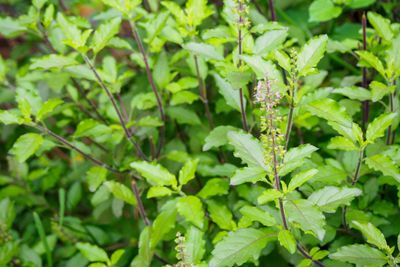What is Holy Basil?
Holy basil (Ocimum tenuiflorum), is closely related to the sweet basil used in kitchens around the world. It is a short-lived, woody, herbal perennial that grows best in tropical and subtropical climates. It grows well in containers for gardens too, and homes in colder regions. In India, holy basil is traditionally grown in containers in and around temples for the purpose of cleansing visitors. Holy basil plants are also important in Ayurvedic medicine and have been used for thousands of years.
Holy Basil Uses
In addition to its religious uses and significance, holy basil is used in cooking and medicine. It is more often used as a culinary herb in Southeast Asian countries, especially Thailand. You can use it in any way that you would use sweet basil: in sauces, salads, stir fries, chicken dishes, pastas, and more. Holy basil’s flavor is spicier than that of sweet basil. Holy basil herbs have long been used medicinally as well. There is some evidence that it is effective in treating and relieving certain symptoms. Holy basil is used for nausea and other stomach ailments, to reduce inflammation, to promote relaxation and alleviate stress, and to relieve headaches, toothaches, ear aches, joint pain, cold and flu symptoms, and fevers.
How to Grow Holy Basil
You can grow holy basil much as you would other herbs, but it does need warm temperatures. Grow it outdoors in the summer, year-round if you are in a tropical or subtropical climate, or keep it in containers that you can move inside in winter. Use a light, well-draining soil that is enriched with organic material, although holy basil will tolerate poor soil fairly well. Your plant will also tolerate some shade, so full sun is not necessary. Keep it watered but not soggy and harvest leaves as needed, just as you would with an ordinary sweet basil plant.
